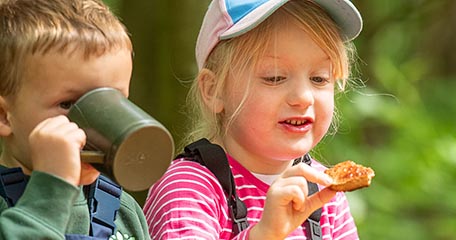Helping children academically using nature
| May 2019So often we when we think of learning we think of paper and pencil. Or maybe we think of watching an educational program or listening to an engaging speaker. It’s important as parents and caregivers to know that movement, and especially movement in free play, is a major contributor to brain growth. In fact, movement it is the pre-cursor to all learning. Here are three easy ways to ensure your child gets the movement he or she needs for optimal brain development.
1. Give your child lots opportunities to practice balancing.

Have you noticed how children naturally look for things to balance on?! Think street curbs and the arms of your couch :). There is an innate drive inside a child to work on their balance skills and to balance on increasingly complex things. An infant is constantly working on balance, moving from rolling to sitting to pulling up. A toddler will try balancing on a log and then jumping a few inches to the ground over and over again. A grade-schooler will also try balancing on a log but one that is suspended over water with the goal of reaching the other side. Middle and high schoolers love things like slack line and ever increasing balancing challenges. As a child’s body and muscles become more coordinated their brain capacity increases. Higher academic achievement is always correlated with higher levels of fitness.
So what can you do? Take your kids outside and expose them to different types of terrain. Moving over uneven terrain will help them as they work on their balance. Hike with your kids and then watch as they are drawn to fallen trees and to large rocks to climb on. Encourage them as they test their bodies and work towards more difficult goals. All of that balancing work will contribute to academic success!
2. Give your child a rich sensory environment.

Every one of our senses carries information straight to our brain. Consider all of the senses that are engaged when a child plays in a stream outside. They feel the coolness of the water, rocks beneath their feet, and mud squished between their fingers. They hear splashes, the sound of moving water, and the chorus of insects and birds. They see all sorts of variations of colours. They see reflections. They see items of all different shapes and sizes. They taste the water as they splash. They may even taste some dirt. And of course there’s the smell of the great outdoors which will vary depending on where you are.
Every square inch of our bodies is designed to take in information and send it to our brain. The more time we allow our children to be in sensory rich environments the greater opportunities there are for brain growth.
So what can you do? Take your kids outside and let them explore with all their senses. The longer the better! Try and find differing environments: a field, a stream, a beach, a forest. The great thing about nature is that even if you frequent the same place often those places are ever changing and will always have something to offer your child.
3. Give your child lots of eye-strengthening opportunities in nature.

When I think about movement I don’t tend to think of my eyes but vision is actually closely related to movement. Every single time we move, our eyes adjust and take in new information. The more our eyes move together, the stronger they become and the stronger the connections to the brain become as well. Tracking with our eyes is an extremely important part of reading and so we want our children to have developed muscles when they reach the age where they are physically ready to read.
Think for a moment about the differences between looking around inside versus looking around outside. Outside the stimuluses are almost infinite. Moving clouds, flying birds, swaying leaves, small insects moving along the ground, etc. Additionally, even in the same location the outside stimulus will change day to day due to weather, season and other factors whereas the inside walls remain largely consistent. Outside the lumens from the sun enter right through your eyes and go straight to the brain elevating the mood. A child in a relaxed and good mood is in a much better state to learn than one who is anxious or depressed. Consider your baby’s eyes when you take her on a hike. As you carry her on your hip or in your baby carrier her eyes are constantly adjusting with the up and down of each step. As you do this you are helping to strengthen her eyes and organize her brain.
So what can you do? Expose your kid’s eyes to the vastness of the outdoors by allowing them to be in nature frequently for lengthy periods of time. It’s always worth your time to let your kids play outside! Give yourself a goal. Schedule it is as one of your first things. And be confident that it will contribute to greater academic success over time.







